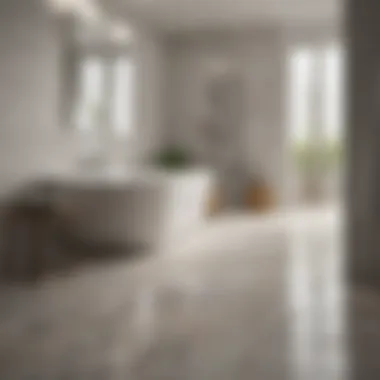Top Flooring Choices for Your Bathroom: A Detailed Guide


Intro
Selecting the right flooring for bathrooms is essential. It affects both functionality and visual appeal. When considering bathroom flooring, homeowners often face various challenges. The flooring must withstand moisture, foot traffic, and the occasional impact from dropped items. Therefore, an informed decision is crucial for lasting satisfaction.
In this article, we will explore several flooring options. We will discuss the pros and cons of each based on specific criteria: durability, water resistance, maintenance, and design compatibility. Our analysis will include popular choices such as ceramic tiles, vinyl, and natural stone. By examining these factors, homeowners can make choices aligned with their needs and styles.
Design Inspiration
Current Trends in Interior Design
In recent times, bathroom design has shifted towards a more cohesive and aesthetic approach. Homeowners prioritize functionality without sacrificing style. Current trends feature minimalistic designs with streamlined fixtures. Natural materials are also increasingly popular, promoting a sense of tranquil living.
Subtle textures and earthy colors dominate many modern bathrooms. For instance, light wood and stone evoke calmness. Some styles incorporate metallic elements to add sophistication. These trends encourage a balance between practicality and a pleasing atmosphere.
Color Schemes and Palette Ideas
Color plays a significant role in bathroom flooring. The right palette enhances the overall aesthetic. Neutral tones such as whites, greys, and beiges continue to be prevalent choices. They provide a clean backdrop for other design elements. A well-chosen color combination can make a bathroom feel larger and more inviting.
Consider contrasting colors for visual interest. For example, a dark floor paired with light walls creates depth. Alternatively, soft pastels introduce warmth and vibrancy, making the space feel refreshing.
"The choice of color in a bathroom can significantly influence mood and perception of space."
Combining different materials can enhance design flexibility. For instance, pairing ceramic tiles with a vintage wood accent creates a unique look. Understanding color psychology helps in making informed decisions that enhance both beauty and functionality.
Through this detailed analysis, we hope to guide readers in making the best flooring choices for their bathrooms.
Prelude
Choosing the right flooring for bathrooms is a critical decision that resonates far beyond mere aesthetic appeal. It intertwines with factors such as water resistance, maintenance, and overall functionality. The bathroom is a unique environment, often exposed to moisture and fluctuating temperatures. Therefore, the flooring material must withstand these conditions while also providing a safe and attractive space.
In this analysis, we explore a variety of flooring options that cater to the distinct requirements of bathrooms. From the durability of ceramic and porcelain tiles to the versatility of vinyl, each choice presents unique advantages and drawbacks. Moreover, we delve into the cost considerations associated with different materials, offering insights that facilitate informed decisions.
The importance of this topic cannot be overstated. Homeowners often consider the bathroom a sanctuary, a space for relaxation and rejuvenation. As such, the flooring not only needs to function effectively but should also complement the overall design aesthetic.
Here, we aim to equip readers—especially homeowners and interior design enthusiasts—with knowledge about how to select the best flooring material based on diverse criteria. By understanding the implications of each option available, one can effectively enhance both the beauty and efficiency of a bathroom.
"The right flooring can elevate a mundane bathroom into a sanctuary, catering to practical needs while also improving visual appeal."
In summary, the topic of bathroom flooring is multifaceted and requires careful consideration. This article will serve as a comprehensive guide, dissecting various options and offering clarity on what makes each suitable for a bathroom setting.
Importance of Bathroom Flooring
Bathroom flooring plays a significant role in determining the functionality, safety, and attractiveness of this essential space in a home. Selecting the right flooring goes beyond mere aesthetics; it impacts everyday activities and overall satisfaction with the bathroom environment. In this segment, we will explore the crucial aspects of bathroom flooring, covering functional requirements, aesthetic considerations, and its influence on home value.
Functional Requirements
The bathroom is subject to moisture, spills, and varying temperatures. Thus, flooring must withstand these conditions without degrading over time. An effective flooring choice needs to provide:
- Water Resistance: Floors in bathrooms must be impervious to moisture. This is vital to prevent mold and mildew growth, which can compromise indoor air quality and trigger health issues.
- Safety: The likelihood of slipping is higher in bathrooms due to wet surfaces. Flooring materials should offer adequate traction to minimize the risk of accidents.
- Durability: Fixtures and fittings can be heavy. Flooring should resist impacts and wear from daily use while maintaining its visual appeal.
A careful evaluation of these functional requirements ensures that the chosen flooring supports daily bathroom tasks while avoiding common pitfalls associated with poor material choices.
Aesthetic Considerations


Beyond practical needs, bathrooms serve as personal sanctuaries. Flooring choices significantly impact the room's ambiance and style. A well-chosen floor complements the overall decor, creating a cohesive look.
- Color and Design: The color palette of the flooring can either brighten up a small space or instill a serene, spa-like atmosphere. The design should harmonize with other elements like cabinetry, wall finishes, and fixtures.
- Textures: Textured flooring options enhance visual interest and contribute to the sensory experience of the bathroom. Glossy tiles may reflect light, while matte finishes can provide a more understated look.
- Tile Layout: The way tiles are laid out can further influence aesthetics. Patterns like herringbone or checkerboard bring dynamism to the floor.
Selecting flooring that marries functionality with aesthetic appeal allows homeowners to create a personal retreat within their homes.
Impact on Home Value
Investing in quality flooring can lead to improved home value. Market trends indicate that potential buyers consider bathrooms as a key factor in property evaluation.
- Quality Materials: High-quality flooring materials like natural stone or premium tiles communicate care and sophistication, attracting discerning buyers.
- Maintenance: Low-maintenance flooring options reduce long-term upkeep costs, making a house more appealing on the market.
- Trends: Staying updated with current trends in bathroom design can attract buyers looking for contemporary features.
In summary, the choice of flooring in a bathroom matters significantly. Functional aspects cater to practical needs, while aesthetic elements enhance the overall experience. Additionally, with the right materials, flooring can potentially elevate a home’s market value. All these elements yield compelling reasons for homeowners to invest time and thought into their flooring decisions.
Types of Flooring Materials
Choosing the right flooring material for a bathroom is essential. Each type has unique characteristics that cater to different preferences and needs. Understanding these options can help homeowners make well-informed decisions. The considerations span durability, aesthetics, price, and functionality. Below is a closer examination of common flooring materials for bathrooms, including ceramic and porcelain tiles, vinyl, natural stone, laminate, cork, and bamboo.
Ceramic and Porcelain Tiles
Durability
Durability is one of the standout features of ceramic and porcelain tiles. These materials have a characteristic hardness that allows them to withstand considerable wear. The density of porcelain, in particular, enhances its resistance to chipping and cracking. This makes it a popular choice for high-traffic areas like bathrooms. Moreover, the scratch resistance of these tiles contributes to their long lifespan, making them cost-effective over time.
Water Resistance
Water resistance is critical for bathroom flooring. Ceramic and porcelain tiles excel in this regard. Their non-porous surfaces prevent water absorption, greatly reducing the likelihood of mold and mildew growth. Given the wet environment of bathrooms, this feature offers peace of mind and promotes a healthier living space. Homeowners can enjoy a stylish floor that effectively manages moisture.
Design Versatility
Design versatility is another strong point for ceramic and porcelain tiles. They come in a wide range of colors, patterns, and textures, allowing for personalized bathroom designs. Whether aiming for a modern look or something more traditional, tiles can fit various decor styles. This flexibility makes them a practical choice during renovations or new constructions.
Cost Analysis
Cost is always a relevant topic when selecting flooring. Ceramic and porcelain tiles are available at different price points. Homeowners can find affordable options while still ensuring quality. Installation costs can vary, but the longevity of the tiles often justifies the expenditure. It is wise to consider both initial and long-term costs when evaluating tile flooring.
Vinyl Flooring
Waterproof Options
Vinyl flooring offers impressive waterproof options, making it suitable for bathrooms. Many vinyl products are specifically designed to be water-resistant or even waterproof. This quality protects the flooring from spills and high humidity levels, making it an ideal choice for wet areas. Therefore, homeowners can have confidence that their flooring will endure the bathroom's moisture.
Comfort and Maintenance
In terms of comfort, vinyl flooring is often soft underfoot and provides warmth, a significant advantage in bathrooms. Maintenance is also straightforward; routine cleaning typically requires just a damp mop. However, scratches may occur over time, which should be monitored. Overall, the comfort and easy maintenance solidify vinyl's place as a favored bathroom flooring option.
Cost Efficiency
Cost efficiency is a crucial consideration for many homeowners. Vinyl flooring is generally less expensive than many alternatives, offering a budget-friendly solution without sacrificing quality. This makes it accessible to a broader audience. Additionally, its resilience means fewer replacements, further enhancing its cost-effectiveness over time.
Natural Stone
Luxurious Appeal


Natural stone has a luxurious appeal that enhances the overall aesthetic of any bathroom. The unique texture and color of each stone type, such as marble or granite, contribute to its upscale look. Homeowners often seek natural stone for creating elegant spaces. It serves not only a functional purpose but also elevates the room's visual impact.
Performance Factors
Performance factors of natural stone include its strength and longevity. Stones like granite are robust, providing a long-lasting flooring solution. However, factors such as porosity must be considered; some stones need sealing to protect against water damage. Evaluating performance helps ensure that the chosen stone meets the specific needs of the bathroom environment.
Installation Considerations
Installation considerations for natural stone can be more complex than some other flooring types. The weight of stone requires sturdy subflooring, and skilled installation may be necessary. While this could mean higher initial costs, the result is often worth the investment in terms of aesthetics and durability.
Environmental Impact
The environmental impact of natural stone can vary. Although it is a natural product, the mining and transport processes can have ecological consequences. However, some stones are more sustainably sourced than others. Homeowners interested in promoting sustainability should research their options carefully when considering natural stone.
Laminate Flooring
Affordability
Affordability is a primary advantage of laminate flooring. It offers a budget-friendly alternative to more expensive materials while still mimicking the appearance of wood or stone. Many homeowners are attracted to laminate for its cost-effective nature, especially in rental situations or temporary housing.
Ease of Installation
Ease of installation is another benefit. Many laminate products come with click-lock systems, allowing for DIY installation without professional help. This not only saves on labor costs but also provides a quicker solution for homeowners looking to update their spaces.
Limitations in Wet Areas
However, there are limitations with laminate in wet areas. While some laminate floors are water-resistant, they are not entirely waterproof. Prolonged exposure to moisture can lead to warping and damage. Homeowners considering laminate in bathrooms should weigh these potential risks against the advantages.
Cork and Bamboo
Eco-Friendly Options
Cork and bamboo flooring are eco-friendly options, appealing to environmentally conscious buyers. They are sourced from renewable materials, making them sustainable choices for bathroom flooring. This eco-friendly characteristic has made them increasingly popular among homeowners focusing on reducing their environmental footprint.
Comfort and Insulation
Both cork and bamboo offer natural insulation, creating a warmer feel underfoot. Cork is particularly recognized for its softness, making it comfortable to stand on. This comfort is a critical factor for bathrooms where users may be barefoot often.
Maintenance Challenges
Maintenance challenges can arise with cork and bamboo. While they are durable, they may require special care to prevent water damage. Their susceptibility to scratching may also necessitate protective measures. Homeowners should be aware of the maintenance requirements to ensure longevity.
Comparison of Flooring Options
When considering flooring for bathrooms, a thoughtful comparison of various options is essential. Each type of flooring presents unique benefits and challenges. Assessing the fundamental attributes such as durability, water resistance, cost, and maintenance helps homeowners make informed choices. This comparison section serves as a guide to efficiently navigate through each material’s distinct advantages and limitations, ensuring the selected flooring meets both practical and aesthetic standards.
Durability and Longevity
Durability stands as a primary concern when selecting bathroom flooring. The bathroom environment, characterized by moisture and frequent foot traffic, requires flooring that can withstand wear over time.
For example, ceramic and porcelain tiles excel in durability, often lasting decades with proper care. They are resistant to scratches and can handle heavy impacts. In contrast, vinyl flooring, though generally durable, may not have the same longevity as tiles, particularly in high-traffic scenarios.
Natural stones like granite or marble bring a luxurious feel, but they can be more prone to chips or cracks if not treated properly. Laminate flooring is usually less durable than other options, especially in the face of moisture. Selecting a flooring type with proven durability is crucial to avoid the need for early replacements and additional costs.


Water and Mold Resistance
Water resistance is critical in a bathroom setting. Moisture exposure can lead to mold growth and structural damage, making this feature imperative in any flooring selection.
Ceramic and porcelain tiles rate highly in this category. They are inherently watertight and can be easily cleaned. On the other hand, vinyl flooring also offers waterproof options, making it a practical choice for those concerned about moisture.
Natural stone has some resistance but usually requires sealing to maintain its durability against water. Laminate flooring, while affordable, is often not recommended for bathrooms due to its susceptibility to water damage if water seeps into seams. Therefore, when comparing options, prioritize materials that inherently resist mold and moisture.
Cost Considerations
Budget plays a significant role in flooring choices. Each flooring material comes with its unique price range, and understanding these costs can help homeowners plan effectively. Ceramic tiles can be more costly at the onset due to material and installation expenses. However, their longevity and durability can offset these initial costs.
Vinyl flooring generally offers a more budget-friendly option. Its lower installation costs and maintenance expenses make it appealing for those with tighter budgets. Natural stone often represents the top end of the market, appealing for its luxurious look but demanding a higher investment.
Ultimately, evaluating costs involves looking beyond just upfront pricing. Consideration of longevity, maintenance, and overall value can lead to sound financial decisions about bathroom flooring.
Maintenance Regimens
Maintenance can vary widely between different flooring types. For instance, ceramic and porcelain tiles require minimal upkeep, typically needing regular cleaning with water and mild detergent. Vinyl flooring also demands low maintenance, although it may need periodic polishing.
On the contrary, natural stone requires more attention. Regular sealing is essential to prevent stains and damage from moisture, which can lead to higher maintenance over time. Laminate flooring may also call for careful cleaning to prevent warping or damage.
Guidelines for Choosing Bathroom Flooring
Choosing the right flooring for a bathroom goes beyond color and texture. The bathroom is a unique environment due to its exposure to moisture and high traffic. Therefore, specific guidelines should be followed to ensure that the flooring selected meets the necessary standards for safety, durability, and aesthetic appeal. These guidelines help homeowners and interior design enthusiasts navigate the myriad of options available while providing clarity on key factors that affect decision-making.
Assessing Your Bathroom Needs
Before selecting flooring, it's crucial to understand the unique needs of your bathroom. Evaluate factors such as the size of the space, the frequency of usage, and specific design preferences. Is it a family bathroom or a guest powder room? High-traffic areas require more durable flooring material. Additionally, consider the potential for water exposure. For instance, a bathroom used frequently may benefit from water-resistant materials like vinyl or ceramic tiles.
"Understanding your bathroom's unique demands is essential for selecting suitable flooring."
Balancing Aesthetics and Functionality
The visual appeal of flooring can enhance the emotional value of a bathroom, but it should not compromise functionality. Aesthetics play a crucial role in how a space feels. However, wet environments require surfaces that can endure moisture without deteriorating. Striking a balance between beauty and practicality is essential. While natural stone can provide a luxurious visual, it may not be the best option due to its maintenance challenges. Alternatively, modern vinyl options offer a variety of designs yet provide the needed durability.
Consulting with Professionals
Engaging with professionals like interior designers or contractors adds great value when choosing flooring. They can provide insights based on experience and may recommend materials tailored to specific needs. Such collaboration might uncover options that are not obvious to a casual observer. Involving experts in the selection process can ensure a more harmonious blend of style and function. Additionally, they can assist with installation considerations that could affect long-term satisfaction with the space.
By following these guidelines, homeowners can confidently select bathroom flooring that meets both aesthetic desires and functional requirements.
The End
Choosing the right flooring for bathrooms cannot be overstated. The flooring you select serves multiple crucial functions. It needs to withstand moisture, resist mold, and blend seamlessly with your bathroom's design. The choices available range from ceramic tiles to vinyl and natural stone, each with its advantages and drawbacks. A thorough evaluation of these options not just impacts the aesthetics of your space, but also plays a role in home maintenance and overall value.
The considerations for selecting bathroom flooring should include the unique needs of your household. For example, families with children or pets may benefit from more durable materials like ceramic or luxury vinyl, while those looking for style may choose natural stone despite its maintenance demands. As you contemplate your options, remember to account for the balance between functionality and design.
Final Thoughts on Flooring Selection
Determining the best flooring for your bathroom is about merging practical needs with personal style. Consider the following points:
- Durability and Water Resistance: Prioritize materials that can combat exposure to water and humidity without succumbing to damage.
- Maintenance Efforts: Some materials may require significantly more upkeep than others. Assess your willingness to commit time and resources.
- Budget Constraints: Understand how different flooring materials affect your budget, ensuring that your choice is both financially viable and meets your expectations.
Ultimately, investing time in research will pay dividends in the long run. By choosing wisely, you can enhance not only the beauty of your bathroom but also its comfort and functionality.
"The best choice of flooring is one that harmonizes your household needs with your aesthetic vision, ensuring longevity and style."
Whether you are planning a complete renovation or just a small update, understanding the implications of your flooring material is essential. This article serves as a guide for making an informed choice that aligns with your specific requirements.



